
|
Estamos trabajando en esta página, por lo que pueden haber enlaces perdidos. Gracias por vuestra paciencia ;)
|
WME provides an ability to override the turn instructions provided during navigation so that editors can customize those instructions to better match the reality of the road.
Use a Turn Instruction Override (TIO) whenever the default Waze selected instruction is not the desired instruction for the driver. The TIO replaces the default Waze selected instruction entirely, including the TTS and instruction list.

|
Don't worry about replacing existing intersection designs that currently produce the desired instruction (such as micro-doglegs and a virtual stub segment). These intersections can be updated as other changes in that intersection are required in the future.
|
Fundamentos
Las instrucciones forzadas de giro (IFG ó TIO de inglés) se desarrollaron para situaciones poco comunes donde las instrucciones predeterminadas de Waze no proporcionan las indicaciones de navegación esperadas. No pretende cambiar el estilo de edición a la que los editores habituales están acostumbrados sino que es un refuerzo para situaciones muy concretas. Analizar y verificar las uniones que usan TIO es mucho mas lento y tedioso por lo que la mayoría mayoría de los cruces deberían usar las instrucciones predeterminadas de Waze.
Cuando mantener las instrucciones predeterminadas de Waze
Nunca fuerces una instrucción hasta que hayas considerado el contexto, las compensaciones y las alternativas.
¿Cuando no se deben anular las instrucciones predeterminadas de Waze?:
- Mejora insignificante. Las instrucciones de navegación son importante tanto para los conductores como para los editores que diagnostican problemas de navegación. Por lo tanto, no agregues una IFG si no vas a reducir significativamente la confusión del conductor sobre la instrucción predeterminada.
- Correcciones simples en la geometría del segmento lograrán la instrucción deseada. Cuando la geometría en una intersección no es la correcta, proporcionará una instrucción no deseada, por lo que si detectas que hay un fallo en la misma y antes de forzar una instrucción, prueba a corregir la geometría, esta actitud siempre será prioritaria. Ten en cuenta los ángulos construidos deliberadamente para fines especiales y asegúrate de preservar la funcionalidad para la que fueron diseñados ( ya sabes, edición de editor experto y activo, pregunta antes de cambiar nada).
- No forzar instrucciones en un cruce que proporciona ya esas instrucciones de forma predeterminada. No tienen ningún sentido, es pérdida de tiempo para quien edita (que no aporta nada) y sólo consigue el mapa sea más difícil de mantener.
- Maniobras obvias. Si Waze por defecto no proporciona instrucciones para una maniobra obvia, no fuerces una. Las maniobras obvias generalmente implican buena visibilidad, geometría intuitiva o convencional, señalización clara y simplemente, no hay mas opciones que realizar esa maniobra.
- Cambios que no afectan al conductor. No fuerces una instrucción simplemente para confirmar los cambios en el nombre, estado, vecindario o dirección cardinal de una carretera. Esto se duplica cuando dichos cambios no están firmados y la información no puede ser útil para el conductor. Además, la aplicación Waze muestra de manera destacada los nombres de las carreteras a lo largo de la ruta, por lo que dicha información ya estará disponible para el conductor sin forzar una instrucción.
- Changes that do not impact the driver. Don't force an instruction simply to confirm changes in a road's name, status, neighborhood, or cardinal direction. This goes double when such changes are unsigned and the information can be of no use to the driver. Besides, the Waze app prominently displays road names along one's route, so such information will already be available to the driver without forcing an instruction.
La instrucción "Continuar"
La instrucción forzada "Continuar" tiene implicaciones diferentes a otras anulaciones de instrucción sobre el nodo. Es una instrucción informativa, ya que no le dice al conductor que ajuste el rumbo. Sin embargo, Waze emitirá la instrucción "Continuar" como lo haría con cualquier otra, ofreciendo múltiples advertencias anticipadas y una alerta final en la ubicación del anulación.
Como resultado, la instrucción forzada "Continuar" es una espada de dos filos. Por un lado, es una forma de notificar al conductor sobre una actuación en la carretera pero por otro lado, el conductor recibirá múltiples y repetidos avisos de voz para no hacer nada. Por eso antes de agregar un "Continuar", valora si realmente merece la pena.
Beneficios
Manejo de imprevistos. Alertar al conductor sobre un cambio no esperado , como de una de la carretera a una rampa de entrada a la autopista) o sobre un cambio inesperado y posiblemente problemático en el estado legal / financiero de la carretera;Surprise management. Alerting the driver to a potentially surprising change in roadway character (for example from a surface street to a freeway onramp) or to an unexpected and possibly problematic change in the roadway's legal/financial status;
Para uso de un "Continua" no intuitivo. Confirmando que se debe continuar adelante aunque parezca entrar en conflicto con la carretera, el tráfico o la señalización vial; Counterintuitive continues. Confirming that one should continue ahead even if doing so seems to conflict with roadway, traffic, or signage cues;
Cambios de larga distancia. Asesoramiento al conductor sobre desvíos hacia las carreteras principales a grandes distancias (particularmente cuando se hace el cambio a carreteras de mayor importancia desde rutas menos significativas) para establecer el contexto para una instrucción posterior que puede estar a horas de distancia; y Long-haul transitions. Advising of transitions to major roadways that the driver may be on for great distances (particularly when transitioning "up" to such roadways from less-significant routes) to set context for a subsequent instruction that may be hours away; and
Notificación de renumeración de salida (controvertido). Marcar un cambio en la numeración de salida de la autopista. Pocos editores consideran que este beneficio en sí mismo compense los inconvenientes de forzar una instrucción Continuar.
- Exit renumbering notification (controversial). Marking a change in freeway exit numbering. Few editors consider this benefit by itself to be worth the drawbacks of forcing a Continue instruction.
Inconvenientes
- Instrucción de bloqueo. Suprimir una instrucción de navegación "real" que viene después de Continuar, para que el conductor no reciba ninguna advertencia de una maniobra requerida hasta que pase la Continuación;
- Instrucción latigazo cervical. Cuando las instrucciones bloqueadas tienen lugar inmediatamente después de Continuar, el conductor puede no tener tiempo suficiente para ejecutar la instrucción bloqueada una vez que se emite. El Continuar puede incluso contradecir la señalización de la instrucción bloqueada y provocar un falo por parte del conductor, por ejemplo, al instruir un Continuar incluso cuando el conductor pasa los letreros que le indican una salida requerida;
- Redundancia / confusión. Confundir a los conductores al emitir lo que puede parecer una instrucción de manejo innecesaria cuando la mejor continuación parece obvia, especialmente si no hay otras opciones posibles; y
- Repetición / distracción. Distraer a los conductores con varias repeticiones de una instrucción de baja prioridad, redundante o inaceptable cuando prefieren atender otras cosas.
Encontrarás una lista de situaciones donde el uso de Continuar, puede ser aceptable y compensar sus inconvenientes. La opción se usar esta característica, puede variar de una región a otra, por lo tanto, es importante que te remitas a las decisiones adoptadas en tu comunidad, a tu coordinador de área o a los coordinadoresde la Comunidad. En caso de duda, no agregues una IFG- TIO Continuar
- Instruction blocking. Suppressing a "real" navigation instruction that comes after the Continue, so that the driver receives no warning of a required maneuver until past the Continue;
- Instruction whiplash. When blocked instructions take place immediately after a Continue, the driver may be left with insufficient time to execute the blocked instruction once it issues. The Continue may even contradict signage for the blocked instruction and set the driver up to fail, for example by instructing the Continue even as the driver passes signs advising of a required exit;
- Redundancy/confusion. Confusing drivers by issuing what may appear to be an unnecessary driving instruction when the best continuation seems obvious, especially if no other course is even possible; and
- Repetition/distraction. Distracting drivers with several repetitions of a low-priority, redundant, or unactionable instruction when they would prefer to attend to other things.
The list of Continue use cases later in this article attempts to balance these tradeoffs. These tradeoffs may be balanced differently from region to region, so check your state's page for additional guidelines or contact your State Manager or Regional Coordinator. When in doubt, do not add a Continue TIO.
Cómo se usa
Creación

|
Antes de establecer una instrucción forzada anulando las instrucciones de giro proporcionadas por defecto, consulta con algún editor senior , Champ o coordinadores.
|
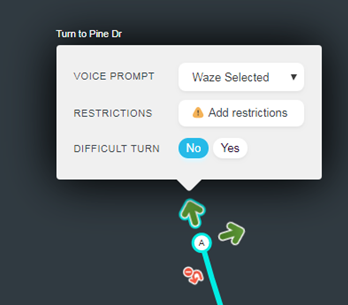
Cuando estés en el WME y haz clic en un segmento y pase el cursor sobre una flecha de restricción / conexión de giro verde o amarilla, aparecerá un cuadro gris con el Aviso de voz, Anulación de instrucción de giro (IFG-TIO), la Restricción de giro basada en el tiempo (TBTR), y seleccion de giros difíciles. Si el giro es rojo (restringido), el cuadro gris no aparecerá.
Haz clic en el menú desplegable Mensaje de voz para seleccionar la nueva instrucción.
Opciones disponibles
Cuando haces clic en el menú desplegable Mensaje de voz, tienes las siguientes opciones:
| Ajuste | Instrucción dada |
|---|---|
| Elejida por Waze (predeterminada) | (nos dará la instrucción por defecto) |
| No | No dará ninguna instrucción |
| Gira a la izquierda | The instruction "turn left" is given |
| Gira a la derecha | The instruction "turn right" is given |
| Mantente a la izquierda | The instruction "keep left" is given |
| Mantente a la derecha | The instruction "keep right" is given |
| Continuar | The instruction "continue straight" is given |
| Sal a la izquierda | The instruction "exit left" is given |
| Sal a la derecha | The instruction "exit right" is given |
| Cambia de sentido | The instruction "make a U-turn" is given |
Cuando seleccionas algo diferente a "Elegida por Waze", la la instrucción seleccionada aparecerá en la pantalla de aviso de voz cuando pasa el cursor sobre las flechas de giro (verde o amarilla).
Identificarlas en el mapa
- La forma predeterminada de saber si un giro tiene un conjunto de instrucciones forzadas, es pasar el cursor sobre la flecha del giro.
- WME Toolbox te ayuda a identificar los giros con instrucciones forzadas establecidas.
Quitarlas
Para eliminar una IGF- TIO, simplemente vuelve a configurar la opción "Elegida por Waze"
Ejemplos de casos de uso
Giro en U (U-turn)
This works well for one way segments that have a u-turn only lane. You can post a "u-turn" verbal prompt on the first left turn and "None" on the second one.
Gira
Streets meeting at less than 46 degrees
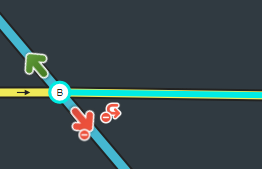
If drivers reaching a junction tend to slow and/or stop at an angle less than 46° to the crossroad, but a turn left or right instruction is still warranted, a TIO may be used to force a turn instruction. Angles greater than 46° will issue turn instructions automatically and should not be overridden.
Before Waze introduced override capability, editors forced turn instructions at such intersections by adding "dogleg" geometry nodes to ensure junction angles between 46° and 170° exclusive. When concerned about the display, editors added doglegs at such fine scale as to be nearly invisible; these are called "micro-doglegs". Doglegs and micro-doglegs continue to work properly and there is no present need to replace them with overrides.
Note that doglegs remain a correct and useful technique. They are completely appropriate when they reflect the typical path of drivers as they slow and stop for a turn. Even if drivers tend to approach at very sharp angles, doglegs may be used to widen the junction angle to at least 20° whether or not a TIO is used. This makes it easier for drivers to identify the turn for closure via the app, as well as for editors to select the segment when using limited mobile tools (typically to drop or raise locks by request).
Other pre-override instruction-forcing methods, especially short "segment to nowhere" stubs and deliberately incorrect alternate names, are no longer appropriate. They continue to work, however, and should be updated with care.
Ambiguous turns
By default, Waze offers no instruction when two streets meet at their terminus and each can only turn into the other. In most cases the necessary maneuver is obvious and no instruction is required. However, if the turn is sharp and visibility is poor (e.g. due to steep grades, walls, buildings, or foliage) or the junction also involves an unmapped private, service or parking-lot road significant enough that the average driver could consider it a potential route, force a turn instruction to confirm the correct route.
At-grade connector

Depending on the length and angle of an at-grade connector, it may make sense for Waze to instruct "keep right/left" or "turn right/left". Use a TIO to ensure the most appropriate instruction is given to the driver. An example of an at-grade connector using an instruction override is shown here:
Sal/Mantente
Sal a la izquierda
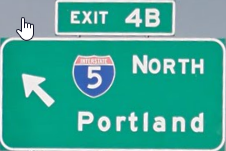

When there is a Big Green Sign (BGS) indicating an exit left, then add the Exit Left TIO. Some exit left signage might be yellow.
Discuss with your Regional Coordinator(s) and/or State Manager(s) to see if they want it added to locations where an HOV or HOT/Express Lane is separated from the regular freeway, highway, etc.
Wayfinder
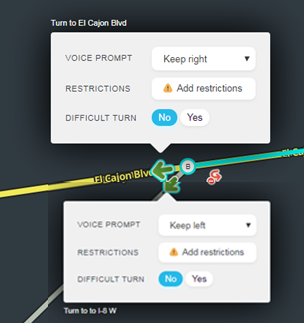
A simple wayfinder is a turn instruction override where an instruction would not normally be voiced. This is most often a "stay to the right" or "stay to the left." A basic example is a roadway with a split where left lanes turn left and right lanes go straight ahead.
To ensure the driver is kept on the correct side of the roadway to stay on the expected route, we create an instruction override to ensure the driver is given enough advance notice to make sure they are on the correct side.
The image here is a composite showing both turns with the override set and which instructions have been applied in this specific case. To drivers continuing straight, the app will give the instruction "stay to the right to El Cajon Blvd." To drivers getting into the on-ramp, the app will say, "keep left to I-8 W."
A complex wayfinder is one where the s-out stubs are named differently than the subsequent segments. The stubs are named for the Big Green Sign (BGS) verbiage for clarity. Before overrides, complex wayfinders used unnatural road types to force instructions, but now these wayfinders should use correct road types and alternate names on the stubs where name continuity is to be preserved, along with TIOs to force instructions. See Wayfinder for further details.
Unusual on-ramp
A default surface-road-to-on-ramp "exit" instruction may be overridden with a "keep" in rare cases when either of the following conditions exist:
- The originating highway's continuation path is unclear (such situations often require wayfinders as well).
- The on-ramp's initial departure continues to share direction and pavement with the originating highway, either for an unexpectedly long distance or leading to two or more subsequent distributor on-ramps that are better instructed as exits than the initial departure. The latter application avoids issuing multiple "exit" instructions for what is effectively the same on-ramp.
Aside from the above situations, do not override the default "exit" instruction for shallow-angled on-ramp departures. While not immediately intuitive for new Wazers, "exit" is nevertheless Waze's current default for these situations. Overriding this default on a large scale could lead to problems. Meanwhile, our only alternative, the "keep" instruction ("stay" in some voices), is not always significantly clearer.
Continue
Unannounced roads with legal or financial implications
Restricted areas (border control point, military base)
When the best continuation is to a restricted area, add a Continue TIO, paired with a named stub segment if necessary, to let users know they will now be entering a restricted area.
Toll
When the best continuation is tolled, marked or unmarked (toll roads, bridges, paid entrances into large areas, etc.), add a Continue TIO, paired with a named stub segment if necessary. For barrier-toll systems, add the TIO only at the beginning of the toll area. Do not force a Continue at intermediate toll barriers.
Setting context in the instruction list
Without a Continue TIO, the next instruction could be from an entirely different road or freeway. Adding a Continue TIO would help set the context as to where the instructions are and increase the Wazer's confidence in the instructions given (or not given).
Terminus of a freeway
Where a freeway ends with a best continuation onto another freeway, add a Continue TIO to indicate the name of the continuing road.
When possible, do this at a point where the user can use this TIO to make a mental confirmation.
If the continuing freeway is signed before the terminus, place the TIO at the last exit, similar to how a wayfinder is set up today.
If it isn't signed, place the TIO where the freeway merges into the next freeway.
Consult with your state manager if the freeway status changes frequently or gradually, or if the freeway itself is insignificant. There could be multiple options as to what would be the best spot for a TIO, or if one is needed at all.
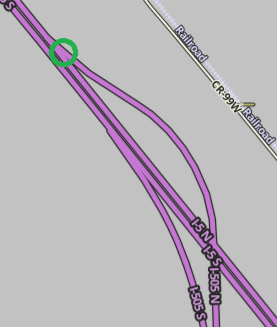 |
On-ramp to a freeway
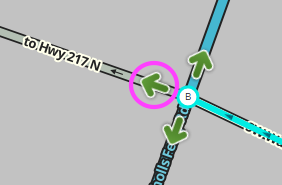
When the best continuation from a road (including off-ramps, parking lot roads, and rest areas) is an on-ramp to a freeway or expressway, add a continue TIO.
Continuing from an off-ramp
Use a Continue TIO when the name of the best continuation at the end of a ramp is not immediately obvious. Here are two scenarios that it's not immediately obvious:
Supplement a wayfinder
Because controlling the turn angles in Waze will never produce a continue instruction, a Continue TIO must be set in places where a wayfinder is warranted for a particular direction, but "keep" or "exit" would be misleading.
Add a continue TIO when:
- All travel lanes are correct—telling a user to "keep" or "exit" would mean an unnecessary lane change to that side of the road out of caution; or,
- Only the center lanes are correct in a 3-way fork.
Best continuation is not the obvious continuation
Many times, when there are many turn lanes, many vehicles turning, and a plethora of signage, and straight ahead doesn't look like the right way to go, the Wazer may be hesitant that Waze is not issuing an instruction. Add a continue TIO to help assure the Wazer that continuing straight is the correct way.
Use selectively, and consult your fellow area managers for consensus.
